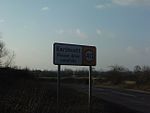Tytherington railway station

Tytherington railway station served the village of Tytherington in South Gloucestershire. The station was on the Yate to Thornbury branch line that was opened by the Midland Railway in 1872. The station was designed by the Midland Railway company architect John Holloway Sanders.Tytherington was a small station with a single platform on a single track section of the line. There was a single-storey wooden building. The station was closed to passengers with the rest of the line in 1944, but remained open for goods traffic until 1963. In mid 2013, the line beyond Yate Middle Jn was signed 'Out of Use' by Network Rail due to the quarry being mothballed and rail traffic having ceased.. The line has since been reinstated with regular freight workings from Tytherington Quarry to Calvert and Didcot The station building has now been demolished, but the station master's house remains in residential use.
Excerpt from the Wikipedia article Tytherington railway station (License: CC BY-SA 3.0, Authors, Images).Tytherington railway station
Station Lane,
Geographical coordinates (GPS) Address Nearby Places Show on map
Geographical coordinates (GPS)
| Latitude | Longitude |
|---|---|
| N 51.5907 ° | E -2.4796 ° |
Address
Station Lane
Station Lane
GL12 8BP
England, United Kingdom
Open on Google Maps





